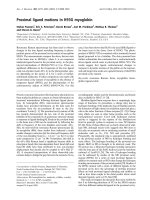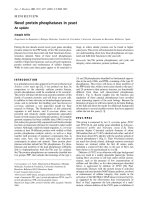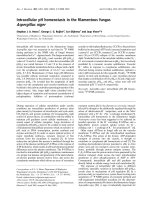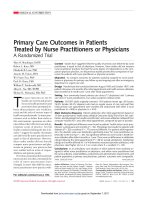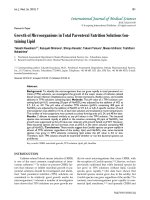Báo cáo y học: "Hypertonic saline resuscitation in sepsis" pps
Bạn đang xem bản rút gọn của tài liệu. Xem và tải ngay bản đầy đủ của tài liệu tại đây (30.12 KB, 2 trang )
Available online />The present discussion focuses on the review by Oliveira and
coworkers [1] (presented in this issue), and on the use of
hypertonic saline resuscitation in sepsis. Early fluid
resuscitation of patients with systemic inflammatory response
syndrome reduces the incidence of mortality due to septic
shock and sepsis [2]. These favorable results have led to
consideration of other fluid modalities. In their review, Oliveira
and coworkers consider the use of hypertonic saline
solutions in the treatment of patients with severe sepsis.
Hypertonic saline has been extensively investigated in animal
models with regard to its efficacy in treating hemorrhagic
hypotension [3]. Numerous clinical studies of patients with
traumatic injuries have been initiated with favorable, but not
definitive, results [4]. Limited animal studies have been
directed at treatment of septic shock using hypertonic
solutions, and clinical studies have been exploratory at best.
Hannemann and coworkers [5] studied 21 stable patients
with septic shock. Patients were administered 2–4 ml/kg
hypertonic saline in hydroxyethyl starch. Following
administration there was a small effect on oxygenation by
increasing cardiac output and oxygen delivery. There was no
control group in this study for comparison. An abstract
reported by Oliveira an colleagues [6] described a
randomized study of 25 stable patients with sepsis.
Administration of 250 ml hypertonic saline in dextran
significantly improved cardiac index and pulmonary artery
occlusion pressure as compared with administration of an
equivalent volume of normal saline. Although favorable, those
studies of responses to hypertonic saline solutions in stable
patients with sepsis are only descriptive. Furthermore,
administration of hypertonic saline solutions during the early
stages of septic shock when the patient is not yet
hyperdynamic has not been investigated.
The major benefit of hypertonic solutions is the rapid
expansion of blood volume for a small volume administered
[7]. This advantage is sustained by the addition of colloids
such as dextran. In their review, Oliveira and colleagues [1]
suggest that the major benefit of resuscitation with
hypertonic solutions in models of septic shock is the
restitution of blood volume and accompanying improvements
in cardiovascular and hemodynamic function.
Hypertonic solutions have been demonstrated to modulate
the immune system [8–10]. As pointed out by Oliveira and
coworkers [1], hypertonic saline has a pronounced anti-
inflammatory effect that could reduce the response to sepsis
and attenuate later multiple organ failure. Recently, Shi and
coworkers [11] found resuscitation with hypertonic saline to
Commentary
Hypertonic saline resuscitation in sepsis
Charles E Wade
Adjunct Professor, Department of Neurobiology, Physiology and Behavior, University of California at Davis, Davis, California, USA
Correspondence: Charles E Wade,
Published online: 21 August 2002 Critical Care 2002, 6:397-398
This article is online at />© 2002 BioMed Central Ltd (Print ISSN 1364-8535; Online ISSN 1466-609X)
Abstract
The review by Oliveira and colleagues on the subject of hypertonic saline resuscitation in sepsis
(included in the present issue) suggests possible benefits for hypertonic saline. There is a firm
experimental basis for the actions of hypertonic saline/hyperoncotic solutions in hemorrhagic
hypotension, which include expansion of blood volume, improvement in cardiac index, favorable
modulation of the immune system, and improvement in survival. These actions are presumed to be of
benefit in the treatment of sepsis or septic shock. However, there are few experimental data regarding
the use of these solutions, and clinical studies are descriptive. The major impact of early administration
of hypertonic solutions may be attenuation of tissue injury, sepsis, and septic shock. Early and
aggressive fluid resuscitation with hypertonic solutions to clinical end-points should be investigated in
patients with systemic inflammatory response syndrome, sepsis, and septic shock.
Keywords hemorrhage, hyperoncotic, immune function, septic shock, shock
Critical Care October 2002 Vol 6 No 5 Wade
ameliorate the gut and lung injury seen following use of
Ringer’s lactate. This lack of injury reduced bacterial trans-
location, and would presumably reduce the incidence of sepsis.
Comparisons between various resuscitation solutions on
outcome have been controversial. However, the work of Rhee
and colleagues [12,13] in comparing various solutions
suggests pronounced differences in immune modulation. The
question that must be addressed is whether the presently
available solutions are harmful in conditions in which immune
function is challenged, and are thus inappropriate to use.
Rhee and coworkers showed that hypertonic solutions,
especially when combined with dextran, are superior to
‘standard of care’ solutions. This leads to the conclusion that
presently used solutions may be harmful because they
compromise immune function and that hypertonic solutions
are of benefit because they do not.
In their review, Oliveira and coworkers [1] discuss the use of
hypertonic solutions for treatment of septic shock; however,
they do not refer to the possible prophylactic benefit of early
use of these solutions. The etiology of sepsis is based on a
sustained period of hypoperfusion of vital organs [14]. Rivers
and colleagues [2] demonstrated early resuscitation to
improve survival. The use of hypertonic solutions as the initial
fluid therapy, irrespective of the cause of hypotension or
cardiac insufficiency, may be of benefit in blocking the
cascade that leads to septic shock. In a study of trauma
patients initially resuscitated with hypertonic saline dextran
[15], no cases of sepsis occurred in the hypertonic saline
group as compared with an incidence of 2% in the standard
of care group. Although interesting, this difference was not
significant. The favorable preservation of tissues and immune
function that occurs following early resuscitation of the
hypotensive patient with hypertonic solutions bodes well for a
favorable outcome in the treatment of sepsis.
Oliveira and colleagues [1] point out the probable
advantages of using hypertonic solutions in patients with
sepsis. There is a rapid and sustained expansion of plasma
volume, leading to improvement in cardiovascular function,
rectification of microcirculatory blood flow, and favorable
modulation of immune function. All of these factors may
contribute to improved outcomes in patients with sepsis and
septic shock. Beyond the scope of the present commentary
is the possibility that early resuscitation with hypertonic
solutions could contribute to a reduced incidence of sepsis
by modulation of immune responses and reduced tissue
injury. These improvements following hypertonic saline
resuscitation would have a greater impact on the subsequent
course of patients admitted to the intensive care unit. At
present, although the experimental data are positive and the
rationale for use of hypertonic solutions in the care of
patients with sepsis or septic shock is reasonable, definitive
clinical studies as to the safety and efficacy in this patient
population are still required.
Competing interests
CEW is a faculty member of the University of California at
Davis, which holds the US patent for hypertonic
saline/hyperoncotic solutions. He holds advisory positions in
companies developing these solutions and serves as a
consultant to other companies.
References
1. Oliveira RP, Velasco I, Soriano FG, Friedman G: Clinical review:
Hypertonic saline resuscitation in sepsis. Crit Care 2002,
6:418-423.
2. Rivers E, Nguyen B, Havstad S, Ressler J, Muzzin A, Knoblich B,
Peterson E, Tomlanovich M: Early goal-directed therapy in the
treatment of severe sepsis and septic shock. N Engl J Med
2001, 345:1368-1377.
3. Dubick MA, Wade CE: A review of the efficacy and safety of
7.5% NaCl/6% dextran 70 in experimental animals and in
humans. J Trauma 1994, 36:323-330.
4. Wade CE, Kramer GC, Grady JJ, Fabian TC, Younes RN: Efficacy
of hypertonic 7.5% saline and 6% dextran-70 in treating
trauma: a meta-analysis of controlled clinical studies. Surgery
1997, 122:609-616.
5. Hannemann L, Reinhart K, Korell R, Spies C, Bredle DL: Hyper-
tonic saline in stabilized hyperdynamic sepsis. Shock 1996, 5:
130-134.
6. Oliveira E, Weingrter R, Oliveira ES, Sant’Anna UL, Cardoso PR,
Alves FA, Oliveira RP, Friedman G: Hemodynamic effects of
dextran-hypertonic saline solution in sepsis [abstract]. Shock
1996, 6(suppl):31.
7. Drobin D, Hahn RG: Kinetics of isotonic and hypertonic plasma
volume expanders. Anesthesiology 2002, 96:in press.
8. Junger WG, Combra R, Liu FC, Herdon-Remelius C, Namiki S,
Junger W, Junger H, Loomis W, Hoyt DB, Altman A: Hypertonic
saline resuscitation: a tool to modulate immune function in
trauma patients? Shock 1997, 8:235-241.
9. Rizoli SB, Kapus A, Fan J, Li YH, Marshall JC, Rotstein OD:
Immunomodulatory effects of hypertonic resuscitation on the
development of lung inflammation following hemorrhagic
shock. J Immunol 1998, 161:6288-6296.
10. Corso CO, Okamoto S, Leiderer R, Messmer K: Resuscitation
with hypertonic saline dextran reduces endothelial cell
swelling and improves hepatic microvascular perfusion and
function after hemorrhagic shock. J Surg Res 1998, 80:210-
220.
11. Shi HP, Deitch EA, Da Xu Z, Lu Q, Hauser CJ: Hypertonic saline
improves intestinal mucosa barrier function and lung injury
after trauma-hemorrhagic shock. Shock 2002, 17:496-501.
12. Rhee P, Wang D, Ruff P, Austin B, DeBraux S, Wolcott K, Burris
D, Ling G, Sun L: Human neutrophil activation and increased
adhesion by various resuscitation fluids. Crit Care Med 2000,
28:74-78.
13. Deb S, Martin B, Sun L, Ruff P, Burris D, Rich N, DeBreux S,
Austin B, Rhee P: Resuscitation with lactated Ringer’s solution
in rats with hemorrhagic shock induces immediate apoptosis.
J Trauma 1999, 46:582-588.
14. Moore FA, Moore EE: Evolving concepts in the pathogenesis of
postinjury multiple organ failure. Surg Clin North Am 1995, 75:
257-277.
15. Mattox KL, Maningas PA, Moore EE, Mateer JR, Marx JA, Apra-
hamian C, Burch JM, Pepe PE: Prehospital hypertonic
saline/dextran infusion for post-traumatic hypotension. The
U.S.A. Multicenter Trial. Ann Surg 1991, 213:482-491.




